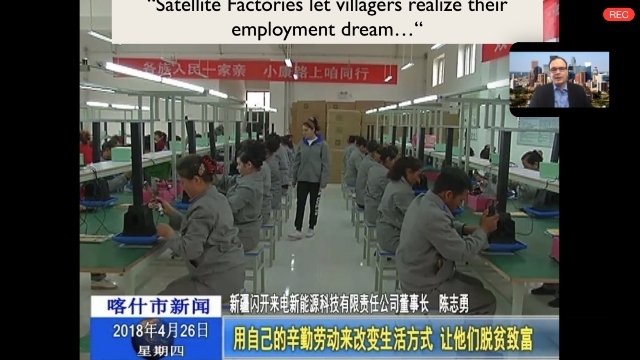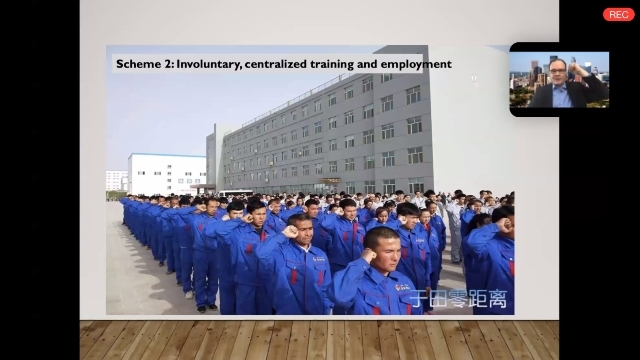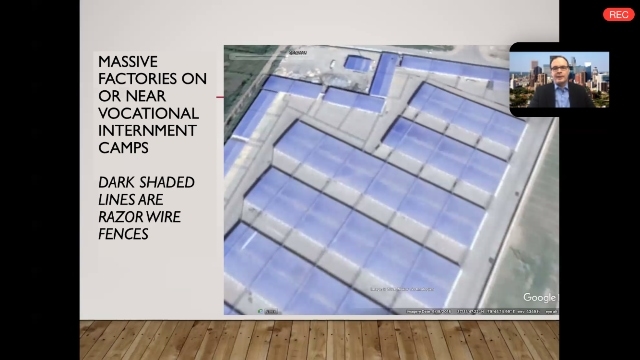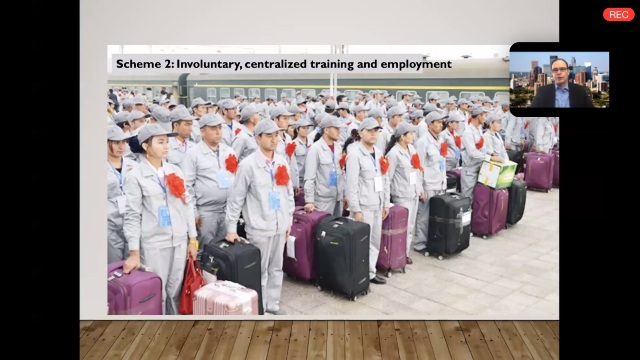Scholar Adrian Zenz exposes how what is advertised as an anti-poverty program in Xinjiang is in fact just another tool to deprive Uyghurs of their identity and coerce them into slave labor.
by Ruth Ingram
Zenz comments on young Uyghur men and women, identically uniformed with matching bags packed, readying for shipment to far flung parts of the Chinese empire to make clothes or telephones for renowned western brands.
Adrian Zenz speaks
Groundbreaking research by one of the foremost researchers on Xinjiang has exposed Beijing’s long-term strategy to subdue the Uyghurs of North West China, which has now reached a pivotal new phase.
According to Adrian Zenz, one of the first researchers to provide incontrovertible proof of the existence of internment camps in 2017, vast numbers of Chinese government published documents and leaked files point clearly to China’s end game vis a vis its minority Muslim population.
The shocking conclusion of his painstaking analysis points to Beijing’s calculated battle plan for its most troubled province to first create a police state, secondly to devise a network of so-called transformation through education camps, and now finally to assimilate the Uyghurs through coercive labor, “weaponized education,” and intergenerational separation.
“The government’s policy is for complete social control,” concluded Zenz, presenting his findings this week at a Victims of Communism Memorial Foundation virtual seminar in Washington.
The truth beyond the “Poverty Alleviation Drive”
Under the guise of Chinese state-propelled “industry-based poverty alleviation” schemes, it is Beijing’s stated aim to have 1 million workers in textile and garment industries, with 650,000 of them coming from Xinjiang’s southern Uyghur majority areas by 2023. Whilst admitting that full employment is not a negative development in itself, Zenz’s main concern is the CCP’s ultimate goal of identity and worldview transformation of the Uyghurs in line with Party ideology. “In this context, labor is hailed as strategic means to eradicate ‘extremist’ ideologies,” he claims.

Using combat terminology, one official report describes poverty alleviation in Xinjiang’s southern four sub-regions and prefectures in terms of “military commands.” It urges every administrative level to pressurize lower levels and fight on a “battlefield” in the “war” against poverty with “full pressure.”
The worrying aspect of the “poverty alleviation drive” in Southern Xinjiang, is that, although similar schemes are being rolled out across China, the main focus in the north west is on predominantly Muslim ethnic minorities on a “massive scale.” “It is coupled here with penetrating social control, a pervasive surveillance state, an unprecedented extrajudicial internment campaign, and a deeper social re-engineering intention on the side of the state that effectively amounts to targeted cultural genocide,” Zenz said, repeating the comments he made last October to the US Congressional Executive Commission on China, in his report, “Beyond the Camps.”
In order to achieve its primary goal of turning Xinjiang into a core manufacturing region within Xi Jinping’s much vaulted Belt and Road initiative, Beijing has enlisted 19 cities and provinces from the nation’s most developed regions under the mutual assistance scheme, to pour billions of Chinese Yuan (RMB) into the establishment of factories in minority regions.
Hundreds of Tik Tok videos coming out of Xinjiang over the past few weeks attest to the mounting body of evidence that Zenz’s suspicions are founded, and prove that thousands of Uyghur young people are being moved en masse around the region and being shipped not only to these factories but also to factories waiting for them in Inner China.
Slave labor within the transformation through education camps
Many of the factories are using internment camp labor. In some instances, hundreds of young people are being rounded up from Southern Xinjiang and forced into coercive labor around the province. Zenz has proof, using State advertisements and policy documents, that the primary focus of the Chinese government is to ensure that everyone who can work, including women caring for children, are in some kind of low-skilled, labor-intensive manufacturing employment, such as textile and garment, electronic assembly, footwear, toys, furniture or handicraft production. “Everyone who can work must be put to work,” assert government policy spreadsheets uncovered by Zenz, which exemplify its “fine-grained poverty alleviation” campaign. Comprehensive databases have been compiled to ensure everyone is accounted for. All exceptions require approval.

Zenz has identified satellite images of large-scale factories on or near transformation through education camps, surrounded by razor wire and surveillance cameras. He has unearthed evidence of new urban settlements being built beside factory parks, and a government document revealing its plans for the Pishan County factory park on the grounds of a transformation through education camp.

“Model” companies and their Western clients
He cites the “model” poverty alleviation company, Jinfujie Clothing Corporation, whose factory on the Kashgar camp’s grounds employs trained minority women and camp detainees. The secret behind its success, it boasts, is its “paramilitary-style management” of minority laborers.
The Meili’ao Fashion Corporation in Shenzhen whose workers have been featured in a State “vocational” internment camp propaganda video, employs detainees immediately after their “graduation” from camps. Workers are described as “returning to normal life after experiencing ‘salvation.’” The company’s chairwoman confirms how she personally witnesses how the process of de-extremization “causes workers to be ‘born again,’” using an interesting religious and Christian terminology.
The Huafu Fashion Corporation, a conduit for many big name western fashion brands, which employs internment camp “graduates,” advertises its own factory ethos, in a statement in line with Government ideology: “A large number of rural surplus laborers are idle at home, which increases the burden on their families and brings hidden dangers to public security.”
Zenz has uncovered a comprehensive scheme to train thousands of “rural surplus laborers,” not only in skills training but underpinned with “military discipline, thought education, including gratefulness to the Party, and Chinese language acquisition; with the underlying aim of obedience to the government, and strengthening their resistance against ‘extremist’ religious thought.” One State propaganda photograph after another parades hundreds and thousands of uniform-clad Uyghurs, marching, swearing their allegiance to the Party, and many with identical bags packed waiting at railway stations to be shipped off to work for their ideological salvation.
Zenz has discovered that underpinning all “poverty alleviation” schemes in Xinjiang is a determination to solve ideological problems. “The aim is to make people who are hard to employ, renounce their ‘selfish’ ideas,” he says. “They need to ‘turn around their ingrained lazy, lax, slow, sloppy, freewheeling, individualistic ways,’ so that they obey company rules,” he says, quoting government notices.
For those who cannot easily be sent away, prong three of the Government push to put everyone to work is a network of satellite factories complete with nurseries for infants, enabling villagers to “realize their employment dream.” Advertised on State TV as “liberating” women to enter full-time factory work, they fulfill the dual function of cheap labor and control over family units. Zenz says that the Chinese government to date has been unsuccessful in changing the spiritual orientation of the largely Muslim group. “In this way, the State has launched an unmitigated push to tear the family apart. Husbands and wives are split up and children are educated by the Party. It is being described as a liberation,” he said.
The world should react
All efforts to turn back the tide of CCP oppression in Xinjiang “have been met with a deafening silence,” says Zenz, who is disappointed that the world community, particularly Muslim nations, has been largely unmoved by the atrocities being metered out against millions of Uyghurs since they began in earnest in 2017. Most nations have too much to lose were they dare to speak against a regime that is propping them up and pouring millions of aid and loans into their coffers.
Zenz’s hope is that now, following proof that much of the world’s supply chains are tainted with slave labor emanating from Xinjiang, there will be a response
“The findings presented call for nothing less than a global investigation of supply chains involving Chinese products or product components, and for a greatly increased scrutiny of trade flows along China’s Belt and Road. They also warrant a strong response from the international community about China’s intrusive coerced social re-engineering practices among Turkic minorities,” Zenz concluded.

